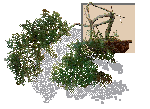| thepotteries.org |
 |
[ History
of Willow ]
The Willow Pattern Ware
|
| article by Mary L. Stollard
Nearly every home in our country contains a specimen of some kind of the famous willow pattern ware. For nearly two centuries, it has been one of the most popular of china designs, and many of us as children have gazed entranced at the quaint little figures of the familiar willow pattern jingle - 'Two birds flying high, Yet even today, many people have never heard the true story of the willow pattern. It tells of Knoon-shee, a lovely Chinese maiden, whose affections were bestowed upon her father's secretary, Chang, but who was commanded by her parents to wed a wealthy rival suitor. She refused to comply with their wishes, whereupon her enraged father locked her up in the little house just visible on the left of the temple. From here she contrived to send a message to her lover, 'Gather thy blossom, ere it be stolen.' Thus encouraged, Chang succeeded in entering the apple orchard and carrying off his beloved. So we see them hurrying over the bridge. Knoon-shee with a distaff, and Chang carrying her box of jewels, while the angry father follows hard after them armed with a whip - in some patterns also accompanied by the discarded lover. The couple made good their escape in the 'Chinese ship sailing by' and landed on the island, which can be seen on the left of the picture, where they took refuge in the little wooden house. But the father and discarded suitor tracked them and set fire to the house while they were sleeping; and so the lovers perished. Next morning, from the ashes rose their spirits, in the forms of two doves. And so we see them with out-stretched wings flying off to the realms of eternal happiness. No one knows the origin of this story. It was told in China more than a thousand years ago and brought over to our country from Eastern lands by the Crusaders. The willow pattern, as we know it today, was designed by one Thomas Minton about 1780, and brought from him by Thomas Turner, a famous potter and manager of Shropshire pottery. At that time the craze for collecting souvenirs from the east was at its height and this dainty little design, so typical of Chinese people, instantly became popular. It was copied, with some variations, by other potters and, though at first sight all willow patterns look alike, the different makes can be distinguished by various small details, such as the number of apples, the figures on the bridge, and the design of the crooked fence. All early potters, however, used the same shade of cobalt blue, and though we have since had many other shades of lighter and darker tones, even browns or blacks, the original cobalt blue has always remained first favourite. Few other makes of china are more attractive than a really good specimens of willow pattern, with their exquisite markings and minute detail carefully and accurately copied.. On the other hand, nothing can be more depressing than mass produced imitations.
|
Questions, comments, contributions?: email Steve
Birks